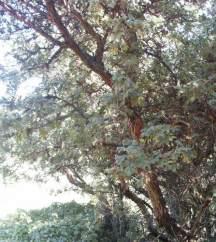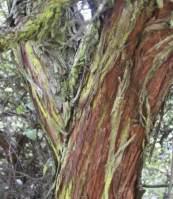Leucosidea sericea
Leucosidea sericea Eckl. & Zeyh.
Family: Rosaceae
Common names: oldwood (Eng.); ouhout (Afr.); umtshitshi (Zulu); isidwadwa, umyityi (Xhosa); mosino (N. Sotho); munyonga-tshifumbu (Venda)
SA Tree No: 145
Introduction
This is a small tree of great character, which grows in the eastern parts of South Africa. It is a very versatile addition to the indigenous garden.

Description
Description
The ouhout is often a straggly shrub or a dense, small, evergreen tree, which grows up to 7 m tall and 5 m wide.

It is single- or multi-stemmed, and it branches low down. The bark is rough, reddish-brown in colour, and flakes off to reveal a smooth light brown under-bark.

The leaves are alternately arranged, compound, and covered with silky, silver hairs. Each leaf possesses 3 to 4 pairs of leaflets. The veins on the leaves are deeply sunken on the upper surface, and protrude on the lower surface. The leaves are a dark green colour above, and a lighter green colour below. The margins of the leaflets are deeply serrated. When the leaves are crushed they have a strong herb-like smell. The flowers are greenish-yellow in colour, star-shaped, and grow in spikes at the ends of young shoots in spring (August to September). The fruits are nut-like and about 3 mm in diameter (December to January).
Conservation Status
Status
Least Concern (LC).
Distribution and habitat
Distribution description
The ouhout is usually found growing in damp conditions, on deep, sandy or clayey, and often rocky, soil. It occurs in the Eastern Cape, western KwaZulu-Natal, the eastern Free State, North West, Gauteng, Mpumalanga and Limpopo provinces, as well as in Lesotho, Swaziland and Zimbabwe.
Derivation of name and historical aspects
History
The generic name Leucosidea is derived from the Greek words for "white or grey appearance", while the species name (sericea) is Latin for "silky", in reference to the silky hairs on the leaves of the tree.
Leucosidea sericea belongs to the family Rosaceae (the Rose family). This is a very large and economically important family. It is mostly found occurring naturally in the temperate regions of the Northern Hemisphere. It comprises 120 genera with 3000 species worldwide, and includes some common fruit crop plants such as the apple, peach, plum, nectarine, pear, apricot, almond, cherry, loquat, quince, blackberry, raspberry and strawberry. This family also includes one of the most popular ornamental plants in the world, namely the Rose. Rose oil is one of the world's most valuable oils, which is used as a base for most perfumes. Rosaceae is however a poorly represented family in Southern Africa, with fewer than eight native tree species and a number of naturalised aliens.
Ecology
Ecology
The flowers and young shoots of this tree are browsed by cattle and goats in spring. It forms dense thickets on overgrazed, eroded or otherwise disturbed areas, and can therefore become a problem plant on farm lands. The ouhout produces nectar which is probably utilised by bees and other insects.
Uses
Use
The wood makes good, durable fence posts in permanently wet soil, even though it is soft. Apparently, in mountainous areas where the ouhout occurs near streams, it is an indication that they are suitable for being stocked with trout. The wood of this tree burns slowly and produces a lot of smoke, like old and decaying wood. This, together with the appearance of the flaky bark, has given rise to the tree's common name of 'oldwood'.
Zulu people use a paste made from the crushed leaves of Leucosidea sericea for treating ophthalmia (an eye ailment). The tree is used as a charm to protect the inhabitants of homesteads.
Growing Leucosidea sericea
Grow
Leucosidea sericea is a frost-resistant evergreen tree, which makes it an ideal species to use to protect less frost-hardy plants during winter. Because it is fast-growing, it can be used to establish an evergreen canopy relatively quickly, while slower-growing trees can be used around it and ultimately take its place once they have developed sufficiently. The tree can also be used to provide shade in summer, if low branches are trimmed off. The ouhout is a dense plant that can be used to provide a screen against noise, objectionable views, and wind. The tree can be very successfully utilised near water sources such as rivers and dams, since it enjoys living in damp areas. It possesses a slightly weatherbeaten and untidy general appearance, due to its gnarled, flaking trunk and irregular form, and these qualities can be utilised well when trying to create a naturalistic indigenous African-style garden. Due to the concentration of silver hairs on the leaf edges, the tree possesses a silvery sheen in the sunlight.
The ouhout is also suitable for use as a bonsai tree.
Leucosidea sericea is propagated easily and quickly from either seed or cuttings. Seeds should be sown in good seedling medium and kept moist. Seedlings can often be found underneath parent plants, and may be carefully removed and planted in nursery bags filled with a suitable soil medium.
References
- Coates Palgrave, K. 1983. Trees of southern Africa. Struik, Cape Town.
- Joffe, P. 1993. The gardener’s guide to South African plants. Tafelberg Publishers, Cape Town.
- Pooley, E. 1993. The complete field guide to trees of Natal, Zululand and Transkei. Natal Flora Publication Trust, Durban.
- Thomas, V. & Grant, R. 1998. Sappi tree spotting: Highveld and the Drakensberg. Jacana, Johannesburg.
- Van Wyk, B. & Van Wyk, P. 1997. Field guide to trees of southern Africa. Struik Publishers, Cape Town.
Credits
Marc Stern
Walter Sisulu National Botanical Garden
June 2002
Plant Attributes:
Plant Type: Tree
SA Distribution: Eastern Cape, Free State, Gauteng, KwaZulu-Natal, Limpopo, Mpumalanga, North West
Soil type: Sandy, Clay
Flowering season: Spring
PH:
Flower colour: Green, Yellow
Aspect:
Gardening skill: Easy
Special Features:
Horticultural zones










Rate this article
Article well written and informative
Rate this plant
Is this an interesting plant?
Login to add your Comment
Back to topNot registered yet? Click here to register.